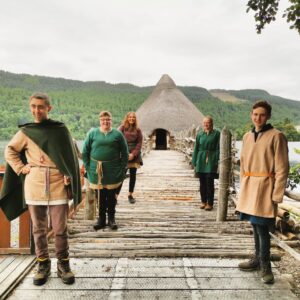Pilot Apprenticeship Scheme: The Scottish Crannog Centre

The Project
Five apprentices began working alongside us here at The Scottish Crannog Centre in August 2020, as part of our pilot apprenticeship scheme. After one month of basic training, the apprentices began to complete units that count towards their accredited Scottish Vocational Qualification (SVQ).
The apprentices have been on site collectively every day since they started, delivering interpretation, and taking been part in all tours – collectively engaging with all 6,500 visitors to the Crannog during the Autumn.
The five apprentices have taken on board a huge amount in terms of work, ethics, delivery and most importantly a confidence in their ability to do the job set in front of them. They have also given back to the Crannog, working on several projects that have become a growing part of the daily interpretation of the Crannog Centre.
"We have a real opportunity to offer a qualification that will keep young people invested in the area and their own career. It also benefits the heritage sector; encouraging it to be activist and uphold social justice, diverse and inclusive, and challenge the status quo for who can access, work at, and change museums."
Rachel Backshall, Community Archaeologist and Event Co-ordinator at the Scottish Crannog Centre
Challenges and successes
- During a pandemic, it was a challenge to welcome and train the apprentices whilst keeping everyone safe and maintaining some of the magic of working at the Crannog Centre. The whole team had to work in an incredibly disciplined way, but we succeeded, and kept the magic!
- The Crannog Community embraced the apprenticeship program with patience and passion in such difficult circumstances.
- We ran workshops with the apprentices where they envisioned what a museum should be, what social issues should be challenged by the sector, and how the Crannog works within this. Through this they developed a shared language for the museums vision, mission and values.
The impact it has made
- Our visitors regularly told us a highlight of their visit was being engaged and inspired by this group of young people.
- The new ideas and young voices have enlivened our museum interpretation and strengthened our roles within both the local and Crannog community. It has also highlighted new strengths in our staff members, and we are learning from each other.
- As well as completing an SVQ, the apprentices have been training in different areas of the organisation that will give them knowledge and work experience for future employment.
- Staff members are currently training to become verified SVQ assessors with the aim to make the museum an SQA centre. This will support us to increase employability in the local area by providing apprenticeship assessment both at the Scottish Crannog Centre and in other businesses.
"Working at the Crannog has shown me my true self and so now I know what I want to do with my career and with my life in general. I feel like I can be myself when I’m with the friends I have made while working there, who are the nicest people!!"
Izzie, Apprentice at the Scottish Crannog Centre
Lessons learned
- Everyone has different needs and skills, and this is a strength.
- Young people are the future of heritage and museums. They bring fresh ideas and are not constrained by convention. This needs to be encouraged and seen for the asset it is.
- Diversifying the Crannog community is always beneficial.
- Learn to let the apprentice’s experience and creativity be self-led – try not to over manage as we want their ideas, not ours.
- How much they can eat! And the importance of Sunday breakfasts!
Guidance
- Peer support for staff is valuable during their work with apprentices.
- Apprentices are not just an extra pair of hands and a funded job placement. We have a responsibility to treat them as valued members of the working community.
- Not to over plan – allow space for the apprentices to make their own decisions. Find what they are interested in and support them to grow and develop in their own direction.
- Try to give them lots of experiences, but make them meaningful and explore what we can learn from them. Outcomes and aims are useful.
- Mutual respect goes a long way.
- Apprentices are not children, they are individuals, so don’t turn them into robots!
Further information
If you would like more information about this project please contact:
Mike Benson, Director, Scottish Crannog Centre, email: MikeB@crannog.co.uk
More information about vocational training in museums can be found here.